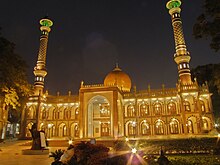This is an old revision of this page, as edited by Rohit Mahra (talk | contribs) at 08:02, 29 December 2024 (Submitting using AfC-submit-wizard). The present address (URL) is a permanent link to this revision, which may differ significantly from the current revision.
Revision as of 08:02, 29 December 2024 by Rohit Mahra (talk | contribs) (Submitting using AfC-submit-wizard)(diff) ← Previous revision | Latest revision (diff) | Newer revision → (diff) islam in karnataka history | Review waiting, please be patient.
This may take 2 months or more, since drafts are reviewed in no specific order. There are 1,849 pending submissions waiting for review.
Where to get help
You can also browse Misplaced Pages:Featured articles and Misplaced Pages:Good articles to find examples of Misplaced Pages's best writing on topics similar to your proposed article. Improving your odds of a speedy reviewTo improve your odds of a faster review, tag your draft with relevant WikiProject tags using the button below. This will let reviewers know a new draft has been submitted in their area of interest. For instance, if you wrote about a female astronomer, you would want to add the Biography, Astronomy, and Women scientists tags. Add tags to your draft Editor resources
Reviewer tools
|
| Submission declined on 21 December 2024 by Significa liberdade (talk).This submission appears to be taken from https://muslimsofindia.com/2022/03/30/islam-in-karnataka/. Misplaced Pages cannot accept material copied from elsewhere, unless it explicitly and verifiably has been released to the world under a suitably free and compatible copyright license or into the public domain and is written in an acceptable tone—this includes material that you own the copyright to. You should attribute the content of a draft to outside sources, using citations, but copying and pasting or closely paraphrasing sources is not acceptable. The entire draft should be written using your own words and structure.
Where to get help
You can also browse Misplaced Pages:Featured articles and Misplaced Pages:Good articles to find examples of Misplaced Pages's best writing on topics similar to your proposed article. Improving your odds of a speedy reviewTo improve your odds of a faster review, tag your draft with relevant WikiProject tags using the button below. This will let reviewers know a new draft has been submitted in their area of interest. For instance, if you wrote about a female astronomer, you would want to add the Biography, Astronomy, and Women scientists tags. Add tags to your draft Editor resources
|  |
| This is a draft article. It is a work in progress open to editing by anyone. Please ensure core content policies are met before publishing it as a live Misplaced Pages article.
Find sources: Google (books · news · scholar · free images · WP refs) · FENS · JSTOR · TWL Last edited by Rohit Mahra (talk | contribs) 25 days ago. (Update) This draft has been submitted and is currently awaiting review. |
Islam had an early presence in the west coast of India as early as the 10th century gained a foothold in Karnataka with the arrival of the Bahmani Sultanate and Adil Shahi dynasty, which ruled parts of Karnataka.

In the 7th century AD, Arab merchants left for the coast of Kearla and Karnataka, thereby beginning the spread of Islam in the Indian subcontinent. Muslims did bring in coffee, and the paper industry among others into the local economy. By the 12th century several Islamic armies had set up sultanates in this region like Bidar Bahamani sultanate(1347-1510) and Bijapur Sultanate during Adilshahi dynasty(1490-1686). This Land came under the Mughals for the first time during the 17th century under the rule of Aurangzeb. Then came the fragmentation of the Mughal power after which Hyder ali and Tippu sultan made Mysore their territorial center. They struggled fiercely against their British colonizers but their resistance was not strong enough to win. Though British killed him in the year 1799, Tipu Sultan was one of the few Indian leaders who ac usetually got the better of the British in battle making him a champion of sorts for modern day Indians. Besides this, a considerable area of Northeastern Karnataka was under the rule of Hyderabad’s Nizam. This region only entered into the fold of Karnataka subsequent to the enactment of the states Reorganisation Act of 1956.
Muslims form approximately 12.92% of the population of Karnataka.
region.
On the other hand, the proportion of Muslims is lower in central Karnataka. The main spoken language of Muslims in interior Karnataka is a dialect called Deccani, often considered to be dialect of Urdu. Pinjara Muslims have Kannada as their mother tongue. At the south western coastal region i.e Dakshina Kannada, Udupi and Kodagu there is concentration of muslims who speak Byari Bashe(mix of malayalam and tulu languages ), Kodava takk and malayalam spoken by sMappila Muslim. Other muslim groups like Nawayath are also found in the region.
References
- Sastri (1955), p396
- Encyclopaedia of India : Pran Nath Copra (1995)
- "A Muslim Wedding in South Karnataka, India". Zawaj.com. 2010-04-27. Retrieved 2024-12-20.
- "Tipu Sultan killed at Seringapatam | History Today". www.historytoday.com. Retrieved 2024-12-20.
- "Karnataka Hindu Muslim Population". www.census2011.co.in. Retrieved 2024-12-20.
- ^ "Language in India". www.languageinindia.com. Retrieved 2024-12-28.
- "Muslim Population in Districts of Karnataka - Muslim Census". 2021-02-27. Retrieved 2024-12-20.
- Dhingra, Sanya. "Why coastal Karnataka is southern India's 'Hindutva laboratory'". Al Jazeera. Retrieved 2024-12-20.
- Sachar Committee Report.